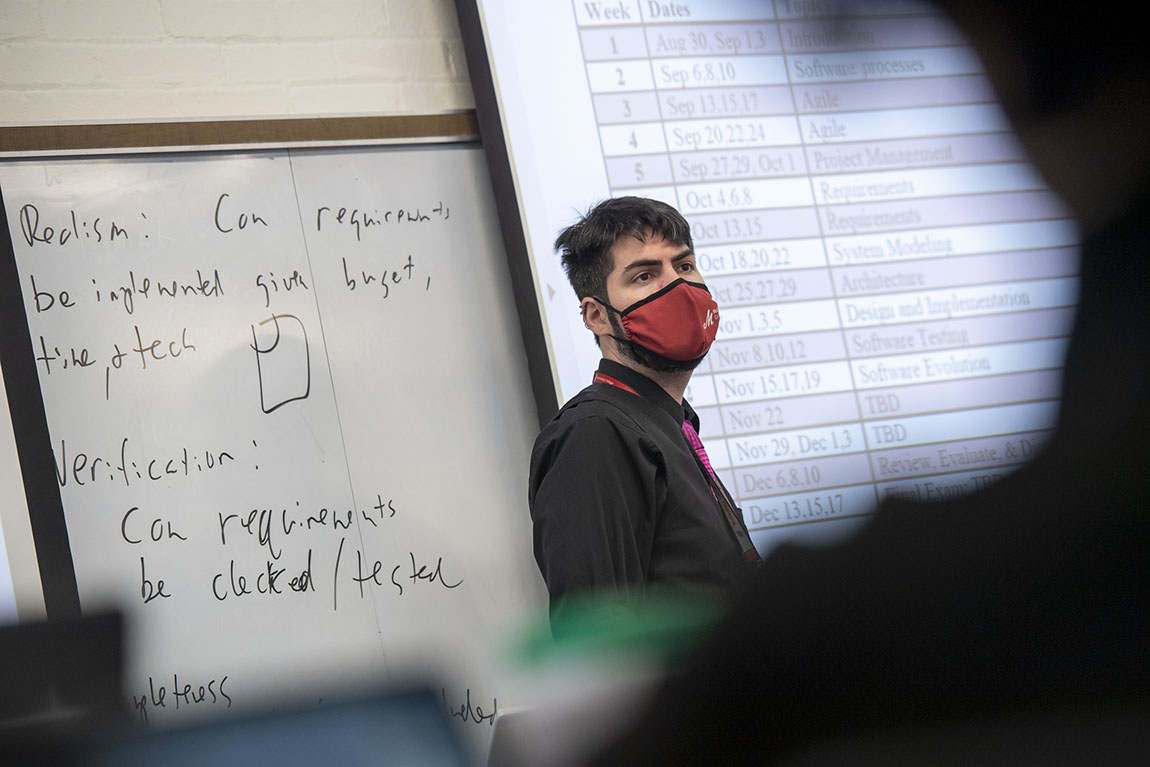Building Together
For Assistant Professor of Computer Science Joseph Helsing, the best part of teaching is collaborating with students on their projects.By: Meghan Kita Wednesday, March 16, 2022 03:28 PM
 Assistant Professor of Computer Science Joseph Helsing teaching in Fall 2021. Photo by Matt Lester
Assistant Professor of Computer Science Joseph Helsing teaching in Fall 2021. Photo by Matt LesterBefore Assistant Professor of Computer Science Joseph Helsing came to Muhlenberg in August 2020, he was a lecturer at the University of North Texas (UNT), where he earned his master’s and Ph.D. There, he taught hundreds of students each semester.
“I missed actually being able to know my students and recognize them and work with them on the more personalized projects they wanted to do,” he says.
He attended Austin College, a small liberal arts college in Texas, as an undergraduate. So when he heard that Muhlenberg was hiring and learned about the College, it felt familiar to him, even though it was a thousand miles away from where he’d lived his whole life, in Texas and Louisiana.
Assistant Professor of Computer Science Jorge Silveyra let Helsing know about the opening. The two had worked together in UNT’s Center for Computational Epidemiology and Response Analysis when Helsing was a Ph.D. student. That lab produced a piece of software called RE-PLAN for local Texas city and county governments in response to the 2001 anthrax attacks. The threat of bioterrorism prompted Congress to pass a law stating that every county needed a plan to distribute prophylactics in the event of an attack. The RE-PLAN software used a combination of geospatial data, software tools and mathematical models to create a plan for how to get vaccines and pills to fight diseases, such as anthrax and smallpox, from government stockpiles to people in need.
“Mathematical models are great, but they don’t always reflect real-world dynamics such as traffic flow accurately,” Helsing says. “My research was building a simulation based on a response plan to determine, can we successfully get doses of vaccines to the population within a time limit?”
What he built looked like one of the city-planning video games he enjoys playing. You could watch cars roll down the road, pause at stop signs and make turns as they carried out the response plan. The research ultimately validated the mathematical model the software used, and he presented it as his dissertation.
At Muhlenberg, he intends to shift toward pedagogical research with his colleagues in computer science, exploring how they might use computational tools to work toward solutions for issues of equity and social justice and how they might collaborate with students in other disciplines.
“Working with computers and knowing really basic programming is kind of a necessity these days, even if it’s just that you know how to do some fancy things in Microsoft Excel,” he says.
Right now, Helsing’s focus is on finding his footing in the classroom after starting at Muhlenberg during the height of the pandemic. This semester, he is teaching Computer Science II and Operating Systems. In the fall, he hopes to debut an integrative learning course with Assistant Professor of Physics Charles Collett in addition to teaching Database Systems and Software Engineering for the second time.
Last fall was his first time teaching Software Engineering, a course in which student teams pitch and execute a project of their choosing. Some of their projects included a dating-style app to match high school students with colleges and universities and a video game with custom artwork and music about a teddy bear fighting through hell.
“Some students had never used some of the technology they were working with, so they had to learn all that stuff during the semester. At the end, they had working projects they could put into a portfolio later on to show to employers,” Helsing says. “My favorite thing to do is always to work with students on projects. The real fun is building something that works.”
